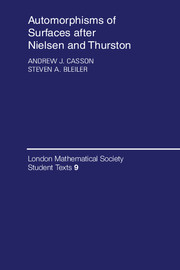0 - Introduction
Published online by Cambridge University Press: 05 August 2012
Summary
Our emphasis Is on closed orientable surfaces, usually denoted by F, with the genus of F, the number of torus summands, denoted by g. An automorphism of a surface F we take to be a homeomorphism h:F → F, usually orientation–;preserving. The Nielsen–Thurston theory generalizes the well–known classification of torol automorphisms to the automorphisms of an arbitrary orientoble surface. We begin by briefly recalling this classification.
Regard the torus as the quotient of the Euclidean plane ℝ2 by the integer lattice ℤ2, endowed with a fixed orientation. Hence π1,(T2) ≅ ℤ⊕ℤ. The homeomorphisms of T2 correspond to the elements of the general linear group GL2(ℤ) as any element oc in GL2(ℤ) maps ℤ2 to itself and so induces a continuous map h∝: T2 → T2. The homeomorphism h∝ has inverse h∝ − 1 and (h∝)*: π1(T2) → π1(T2) has matrix ∝. The mop h∝ preserves orientotion if and only if det(∝) = 1. i.e. ∝ is an element of the special linear group SL2(ℤ).
If ∝ in SL2(ℤ) is represented by the 2×2 matrix, the characteristic polynomial of ∝, t2−(p+s)t+(ps−rq), con be written as t2−(trace(∝))t+1. The eigenvolues λ,λ−1 of ∝ ore either
1) complex, i.e. troce(∝) = 0, 1, or − 1
or 2) both ±1, i.e. trace(∝) = ±2
or 3) distinct reals, i.e. ∣trace(∝)∣ > 2.
Consider each of these cases In turn.
In case 1) an easy exercise in the Cayley–Hamiiton theorem shows thot ∝ is of finite order ond (h∝)12 = 1. The map h∝ Is said to be periodic.
- Type
- Chapter
- Information
- Publisher: Cambridge University PressPrint publication year: 1988

